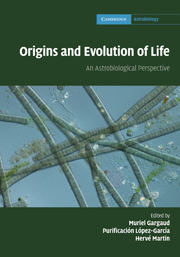Book contents
- Frontmatter
- Contents
- List of contributors
- Foreword
- Preface
- Part I What is life?
- Part II Astronomical and geophysical context of the emergence of life
- Part III The role of water in the emergence of life
- Part IV From non-living systems to life
- Part V Mechanisms for life evolution
- Part VI Life in extreme conditions
- Part VII Traces of life and biosignatures
- 25 Early life: nature, distribution and evolution
- 26 Early eukaryotes in Precambrian oceans
- 27 Biomineralization mechanisms
- 28 Limits of life and the biosphere: lessons from the detection of microorganisms in the deep sea and deep subsurface of the Earth
- Part VIII Life elsewhere?
- Index
25 - Early life: nature, distribution and evolution
from Part VII - Traces of life and biosignatures
Published online by Cambridge University Press: 04 February 2011
- Frontmatter
- Contents
- List of contributors
- Foreword
- Preface
- Part I What is life?
- Part II Astronomical and geophysical context of the emergence of life
- Part III The role of water in the emergence of life
- Part IV From non-living systems to life
- Part V Mechanisms for life evolution
- Part VI Life in extreme conditions
- Part VII Traces of life and biosignatures
- 25 Early life: nature, distribution and evolution
- 26 Early eukaryotes in Precambrian oceans
- 27 Biomineralization mechanisms
- 28 Limits of life and the biosphere: lessons from the detection of microorganisms in the deep sea and deep subsurface of the Earth
- Part VIII Life elsewhere?
- Index
Summary
Introduction
The first two thirds of the history of life on Earth are dominated by single-celled microorganisms with prokaryotes characterizing the time period up to at least the Palaeoproterozoic Period (from 2.5 to about 1.8 billion years (Ga) ago). The oldest recognizable eukaryotes appear in the Mesoproterozoic Era (and are dated at between 1.6 to 1.8 Ga (Javaux et al., 2001, 2004; see also review in Knoll et al., 2006). This chapter on early life will concentrate on the traces of life contained in the oldest crustal rocks potentially capable of hosting well-preserved biosignatures, i.e. Early to Mid-Archaean, 3.5 to 3.0 Ga-old sediments and volcanic rocks from greenstone belts in both the Pilbara (NW Australia) and the Barberton (East South Africa) Greenstone Belts. The fossil traces of early microorganisms in these rocks resemble prokaryotes in terms of their morphology, metabolic processes and interactions with the environment. Life is directly influenced by its environment and, reciprocally, it can also influence its immediate environment. On the microbial scale, this influence is in proportion to the size of the microbial colonies, biofilms or mats, which can range from tens of microns to several metres or more (sometimes up to kilometres) for well-developed mats. For instance, if one takes into consideration the probable microbial control on the rise of oxygen in the atmosphere (between 2.4 and 2.0 Ga; Bekker et al., 2004; Canfield, 2005), this influence also reaches the planetary scale.
- Type
- Chapter
- Information
- Origins and Evolution of LifeAn Astrobiological Perspective, pp. 391 - 413Publisher: Cambridge University PressPrint publication year: 2011
- 19
- Cited by



